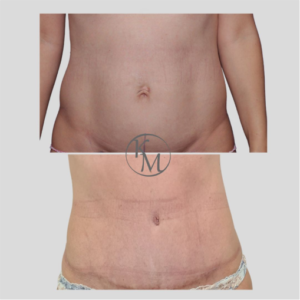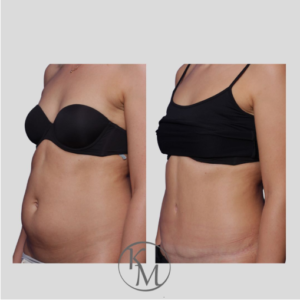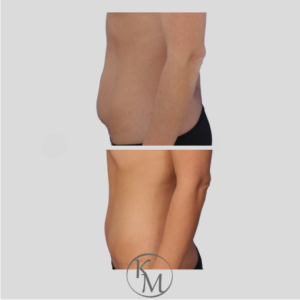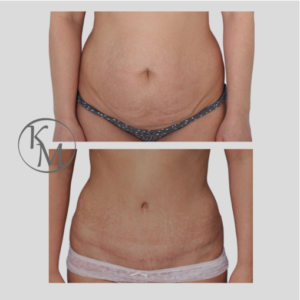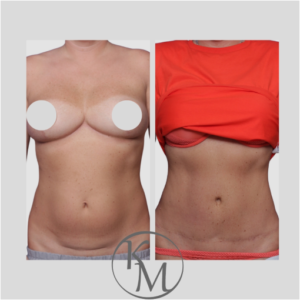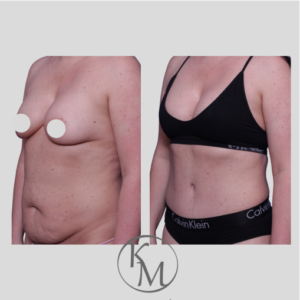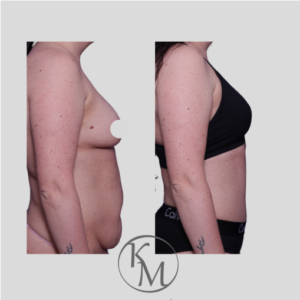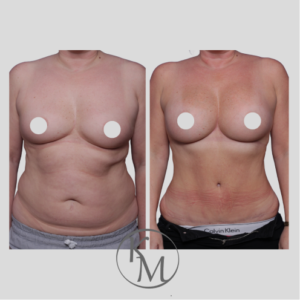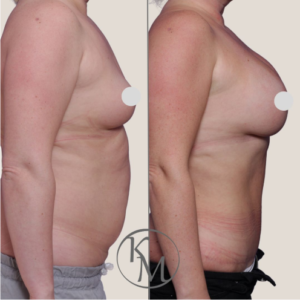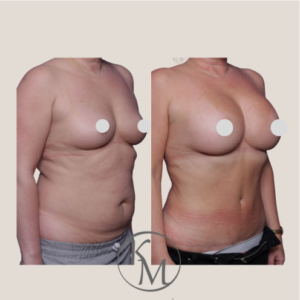Tummy tuck (abdominoplasty) is a surgery that creates a smoother and firmer abdominal contour. The surgery removes excess skin or fat tissue in the abdomen and corrects weakened or separated rectus abdominis muscles. Abdominoplasty can also get rid of stretch marks from pregnancy in the lower abdomen below the belly button. Tummy tuck is recommended for women who are not planning any more pregnancies.
Full or partial abdominoplasty (mini tummy tuck) can be performed: a full tummy tuck surgery is performed when there is excess skin and the abdominal muscles have separated. Mini tummy tuck is relevant when there is only a small amount of excess skin in the lower abdomen. Abdominoplasty and liposuction in the lumbar region are a combination of surgeries, often performed together.
It is important to know that the surgery is performed if the body mass index (BMI) does not exceed 27-28.
Tummy tuck surgery may be relevant:
- There is significant weight loss and excess abdominal skin.
- Stretching of abdominal skin and muscles after pregnancy and childbirth, and/or separation of the latter.
- When sports and a healthy diet don’t help get rid of a protruding belly.
- When the abdominal skin loses its firmness due to ageing processes.
Tummy tuck (abdominoplasty) is a surgery that creates a smoother and firmer abdominal contour. The surgery removes excess skin or fat tissue in the abdomen and corrects weakened or separated rectus abdominis muscles. Abdominoplasty can also get rid of stretch marks from pregnancy in the lower abdomen below the belly button. Tummy tuck is recommended for women who are not planning any more pregnancies.
Full or partial abdominoplasty (mini tummy tuck) can be performed: a full tummy tuck surgery is performed when there is excess skin and the abdominal muscles have separated. Mini tummy tuck is relevant when there is only a small amount of excess skin in the lower abdomen. Abdominoplasty and liposuction in the lumbar region are a combination of surgeries, often performed together.
It is important to know that the surgery is performed if the body mass index (BMI) does not exceed 27-28.
Tummy tuck surgery may be relevant:
- There is significant weight loss and excess abdominal skin.
- Stretching of abdominal skin and muscles after pregnancy and childbirth, and/or separation of the latter.
- When sports and a healthy diet don’t help get rid of a protruding belly.
- When the abdominal skin loses its firmness due to ageing processes.
The process of tummy tuck
The surgery is performed under general anaesthesia and takes about 2-2.5 hours.
The incisions are made in the lower abdomen, from one hip bone to the other. They can be designed so that they are not visible when you put on your underwear. The size of the incision usually depends on the extent of the surgery – the more skin and fat removed, the larger it is, and it can extend to the back. When a full abdominoplasty is required, an additional incision is made around the belly button, as the belly button is sewn into a new location in the skin, but its position in relation to the body does not change. After the incision is made, excess abdominal skin is removed, and weakened or separated abdominal muscles are sutured.
Partial tummy tuck involves a shorter incision only in the lower abdomen, where only the excess skin is removed.
Before surgery
During the consultation, the problem areas and the scope of the future surgery are discussed.
Post-surgery period
After an abdominoplasty, you will stay in the hospital for 1-2 days. Partial abdominoplasty patients can go home earlier and heal faster than full abdominoplasty patients. It is not recommended to return to work for 1-2 weeks.
The abdomen may be swollen and bruised for the first couple of weeks. It may be difficult to stretch for a couple of weeks. After the surgery, the body may accumulate fluid, so there may be some weight gain, but it will fall off in the first few weeks. A special corset is worn for 6-8 weeks after surgery.
It is very important to refrain from exercise after the abdominoplasty—it should be avoided for about three months. It is also recommended that the scar be protected from sunlight for a year.
Surgical risk
Complications are extremely rare but can include infections, haematoma (collection of spilt blood in or between tissues), seroma (subcutaneous collection of tissue fluid), wound infection or leg venous thromboembolism (blockage of a blood vessel), death (necrosis) of part of the tissue, asymmetry of the scar, or enlarged scar. All these complications can usually be avoided by following the surgeon’s recommendations after surgery.
Results
The initial result is visible after a few weeks and the final result is visible after 4 months. It is important to know that maintaining a stable weight, exercising and eating a healthy diet help to maintain long-term results.
Frequently asked questions


